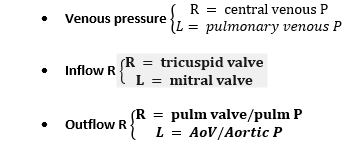15B15: Exam Report
Define cardiac preload and describe its determinants.
29% of candidates passed this question.
This question required synthesis and application of knowledge derived from multiple sources rather than regurgitation of a published list in a text. Many candidates failed to recognise that venous return is not the only determinant of preload. Most candidates failed to discuss determinants of venous return. Factors such as contractility, afterload or chamber filling and
emptying can all impact preload. In addition to listing determinants the question required an explanation of their relationship with preload (e.g. the direction of change).
A discussion about the determinants of cardiac output was not asked for as did not score marks.
G3iii / 15B15: Define cardiac preload and describe its determinants
Definition
Preload = the load on myocardial fibres just prior to the onset of contraction. This relates to sarcomere length at the end of diastole
By F – S Law, the ability of the cardiac muscle fibres to contract is dependent upon & proportional to its initial fibre length
- Sarcomere length cannot be measured ∴surrogates used
- LVEDV: ↑blood in LV = ↑length of myocardial fibres
- Estimated with TTE
- Non-invasive, requires echo competency
- LVEDP: aka ‘Filling Pressure of LV’
- Assumes normal compliance e. no IPPV
- LV compliance = LVEDV/LVEDP
- Estimated with L) heart catherization
- LAP: LAP ≈ LVEDP
- Assuming normal MV because during diastole there should be minimal resistance
- Require L) heart catherization
- PCWP: correlates with LAP
- Assumes normal airway pressures
- Requires no valve pathology (because you really want LVEDP, and you are trying to get that from LAP)
- Requires SGC
- RAP/CVP: index of R) heart preL
- Easy to measure with CVC
Factors Determiing Preload
1) Venous Pressure
- ↑venous pressure = ↑venous return = ↑preL = ↑CO
- Venous P depends on:
- Total Blood Volume
- Gravity
- Muscle contraction
- Venous compliance
2) Ventricular Compliance
- ↑compliance = ↑EDV (preload)
- ↑compliance = ↑filling for any given pressure
3) Heart Rate
- ↓HR = ↑filling time = ↑EDV
4) Atrial Contraction
- At rest atrial kick = 10% ventricular filling
- ↑Symp stimulation = ↑FoC (atria) = 40% ventricular filling
- ∴↑Force atrial kick = ↑EDV
- AF = loss of atrial kick = ↓EDV
5) Inflow Resistance
- ↑inflow resistance (TV/MV stenosis) = ↓EDV
6) Outflow Resistance
- ↑outflow resistance (↑PAP/AoC) = impairs ventricle emptying → ↑EDV (or ↑ESV which contributes to ↑EDV)
7) Ventricular Inotropy
- Ventricle systolic failure = ↓emptying = ↑preL
LV vs RV Preload
Factors determining preL of the ventricles is the same, except

